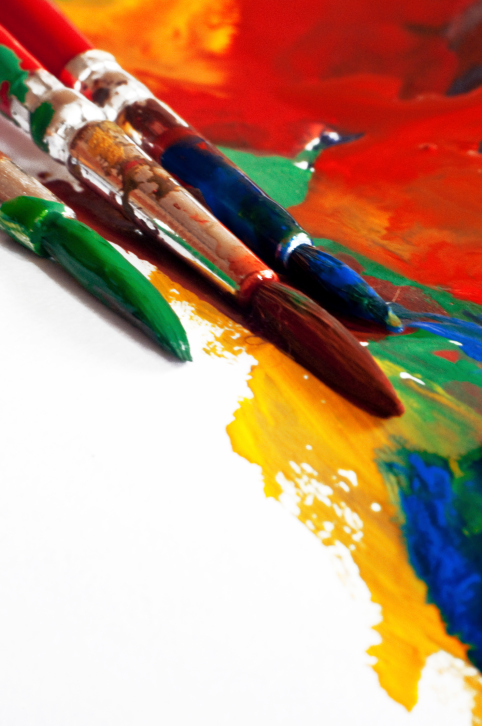Family Art Therapy: Foundations of Theory and Practice E-book

Art therapy , a hybrid field largely influenced by the disciplines of art and psychology, uses the artistic procedure, pieces of fine art created in therapy, and tertiary-party artwork to help people in treatment develop self-awareness, explore emotions, address unresolved emotional conflicts, improve social skills, and heighten self-esteem. Art therapy primarily aims to help individuals experiencing emotional and psychological challenges attain personal well-being and improved levels of office.
Neither previous artistic experience nor natural artistic ability is necessary for successful handling, and any individuals seeking the help of a mental health professional may find benefit from fine art therapy.
- History and Development of Art Therapy
- Contributors to the Field
- Health Bug Treated by Art Therapy
- Art Therapy Techniques and Exercises
- Art Therapy vs Expressive Arts Therapy
- Art Therapist Training and Accreditation
- Limitations and Concerns of Art Therapy
History and Development of Fine art Therapy
Art has been used as a means of advice, cocky-expression, group interaction, diagnosis, and conflict resolution throughout history. For thousands of years, cultures and religions around the earth have incorporated the utilise of carved idols and charms, as well equally sacred paintings and symbols, in the healing process. The establishment of art therapy every bit a unique and publicly accustomed therapeutic arroyo only took identify recently, in the mid-20th century. The emergence of fine art therapy as a profession arose independently and simultaneously in the United States and Europe.
The term "art therapy" was coined in 1942 past British artist Adrian Loma, who discovered the healthful benefits of painting and drawing while recovering from tuberculosis. In the 1940s, several writers in the mental health field began to depict their work with people in treatment every bit "art therapy." Every bit there were no formal art therapy courses or preparation programs available at that fourth dimension, these care providers were often educated in other disciplines and supervised by psychiatrists, psychologists, or other mental health care professionals.
Contributors to the Field
Margaret Naumburg, Hanna Kwaitkowska, Florence Cane, Edith Kramer, and Elinor Ulman were five influential writers of the 1940s who made significant contributions toward the development of art therapy as a recognized field.
Find a Therapist
Margaret Naumburg, often described equally the "female parent of art therapy," established the Walden School in her home urban center of New York in 1915. She is widely viewed as the primary founder of the American art therapy movement. Naumburg believed children who were allowedto express themselves creatively and pursue subjects of interest to them would feel healthier development. Influenced by the psychoanalytic movement prevalent at the time, Naumburg began to view the artistic process every bit a methodology similar to verbal expression—a means of unearthing repressed, unconscious thoughts and emotions. She believed once the symbolic expression of a person's land of heed was combined with the cerebral and exact aspects of experience, healing could take place. Both this expression and healing were believed to be able to occur in an fine art therapy session. She wrote several influential books on art therapy, including Studies of the "Free" Expression of Beliefs Trouble Children as a Means of Diagnosis and Therapy (1947), Schizophrenic Art: Its Meaning in Psychotherapy (1950), and Dynamically Oriented Art Therapy: Its Principles and Practice (1966). These and other publications by leading contributors in the field are withal used and referenced today equally original sources in fine art therapy literature. 
Hanna Kwiatkowski, another major contributor, was built-in in Poland and educated throughout eastern Europe. A talented sculptor and artist, Kwiatkowski somewhen moved to the U.s.a. and began working at the National Institutes of Mental Health, where she bridged the gap between her passion and her profession by introducing fine art into the therapy sessions she conducted with families.
As a effect of these sessions, Kwiatkowska establish the creative expression of drawing to allow family members to better identify their roles and status inside the family. She also saw the significant therapeutic benefits of the drawing procedure. Although she had originally hoped to use her art therapy to assist treat individuals facing intellectual challenges, Kwiatkowska discovered her technique also provided relief to families and individuals who who faced moderate psychological issues and dysfunctions.
Other contributors include Florence Pikestaff, an art educator who utilized didactics methods emphasizing the importance of gratuitous artistic expression and encouraging emotional creativity, and Edith Kramer, who proposed the more procedure-oriented fine art-as-therapy approach that divers goals of supporting the ego, helping the evolution of identity, and fostering growth. Finally, Elnor Ulman established the first art therapy journal in the United States and initiated ane of the earliest grooming programs in the field.
Health Problems Treated by Art Therapy
Art therapy has been shown to benefit people of all ages. Research indicates fine art therapy tin can improve communication and concentration and can aid reduce feelings of isolation. This type of therapy has likewise been shown to lead to increases in self-esteem, conviction, and self-sensation.
Positive results in fine art therapy may often be accomplished by those facing issues such as:
- Anxiety
- Depression
- Substance dependency
- Stress
- Posttraumatic stress
- Attention deficit hyperactivity
- Aging and geriatric bug
- Cancer
- Pity fatigue
- Heart illness
- Anorexia
- Bulimia
- Other eating disorders
- Cerebral impairments
- Family unit or human relationship issues
Because art therapy allows people to express feelings on whatever subject through creative work rather than with speech, information technology is believed to be peculiarly helpful for those who feel out of touch with their emotions or feelings. Individuals experiencing difficulty discussing or remembering painful experiences may also observe art therapy especially beneficial.
Contempo research suggests art therapy may help individuals diagnosed with schizophrenia see improvement of some of their symptoms, although trials are all the same being conducted.
The memoir, Sybil, and two movies of the same name, describe a woman diagnosed with dissociative identity disorder who, through the use of art, appeared to proceeds greater insight virtually her alters and trauma she had experienced in childhood. Painting both provided an outlet for Sybil and her alters to express feelings and rediscover memories of the trauma, which could then be discussed in therapy.
Melinda, the main character of the 1999 immature adult novel, Speak, uses art to cope with traumatic mutism—her inability to speak post-obit a traumatic event—and isolation.
Art Therapy Techniques and Exercises
Certified art therapists will typically accept a comprehensive agreement of the powerful effect that the artistic process tin can have on those in therapy. Art therapists often utilise psychological, spiritual, and artistic theories in conjunction with clinical techniques to achieve the desired therapeutic outcome. The approach has proven to exist beneficial even for non-verbal individuals and professional artists. Mutual techniques used in therapy include:
- Painting
- Finger painting
- Doodling
- Scribbling
- Sculpting
- Drawing
- Using molding dirt
- Carving
- Making pottery
- Making cards
- Using textiles
- Making collages
Art therapy tin can assistance people express those thoughts, emotions, and experiences that may exist difficult to speak nearly. In a 2004 study, 30-2 women with heart disease were first interviewed and and then asked to individually illustrate the disease. The resultant drawings were grouped into three categories: (one) the middle at the centre, (ii) the heart in the lived body, and (three) eye disease as a social illness. The use of colour, spatial arrangement, and composition were analyzed, and the drawings ultimately helped wellness care professionals better appreciate how each woman understood her condition and provided insight on how to all-time to approach each case.
 Illness is ofttimes closely associated with intense emotions, and tactile techniques, such every bit working with molding clay, may provide a refuge from these feelings. These activities take also been shown to be effective in revealing unconscious textile, providing cathartic release, and promoting verbal expression.
Illness is ofttimes closely associated with intense emotions, and tactile techniques, such every bit working with molding clay, may provide a refuge from these feelings. These activities take also been shown to be effective in revealing unconscious textile, providing cathartic release, and promoting verbal expression.
A study in which women with cancer were encouraged to engage in various visual arts exercises and techniques establish that the participants benefited in four key ways. While the women initially experienced a number of illness-related challenges such as loss of confidence, loss of sleep, and altered social relationships, afterwards the study they reported an increased focus on positive life experiences, increased cocky-worth, maintenance of social identity (as opposed to being defined by cancer), and an increased ability to express their feelings in a symbolic fashion.
Numerous other clinical reports take supported the therapeutic benefits of fine art therapy. Chronically ill individuals accept reported better wellness and well-being, and people with chest cancer have reported a decrease in negative emotions and an increment in positive emotions. Further, individuals undergoing hemodialysis handling reported reduced depression, and people adversely afflicted by trauma accept reported lower levels of stress, less compassion fatigue, and an increased sense of purpose.
Art therapists work to aid individuals, families, groups, and communities become more in touch with their emotions. Art therapy has become an integral office of many rehabilitation centers, mental health facilities, crisis centers, private practices, schools, and various other social and community institutions that strive to promote wellness, wellness, and growth.
Art Therapy vs Expressive Arts Therapy
Distinguishing between art therapy and expressive arts therapy may be somewhat hard, every bit both approaches utilise a wide variety of therapeutic techniques to provide mental and emotional relief.
Art therapy oft incorporates techniques such every bit painting, finger painting, drawing, sculpting, and carving. Fine art therapy has become an integral part of manyrehabilitation centers, mental wellness facilities,crisis centers, individual practices, schools, and diverse other social and community institutions that strive to promote health, health, and growth. Since art therapy focuses primarily on the visual arts, information technology is considered a single modality therapy. Expressive arts therapy is considered a multi-modal approach because it integrates techniques from many unlike artistic modalities. To illustrate, an expressive arts therapist may integrate therapeutic principles and tools from poetry therapy, trip the light fantastic toe and movement therapy, music therapy, and fifty-fifty art therapy in i therapeutic session.
Another noteworthy deviation between the two approaches is the terminal production: At the stop of an art therapy session there is likely to be a tangible product (such as a painting, drawing, or sculpture). Expressive arts therapy is not express to the visual arts and then the chief means of expression may be visual, tactile, or auditory. The created product may be tangible or intangible, depending on the technique used.
Art Therapist Training and Accreditation
Art therapy practice requires a knowledge of the visual forms—drawing, painting, sculpture, and so on— every bit well as the creative procedure, human development and psychology, and counseling theories and methodology.
Those who exercise art therapy, even at the entry level, must have earned at least a primary's degree from an accredited establishment. The Educational Program Approval Board (EPAB) uses academic standards set past the American Art Therapy Association (AATA) to evaluate the compliance of art therapy programs with the recommended requirements. Additionally, the body providing accreditation to the tertiary-level institution must be canonical past the Council for College Teaching Accreditation (CHEA).
The Fine art Therapy Credentials Lath (ATCB) was established in 1993. The chief goal of the ATCB is to safeguard the interests of the public by ensuring that practicing art therapists run across and maintain required upstanding and quality standards. The ATCB does this past offering three professional credentials to individuals desiring to be fine art therapists:
- Registered Art Therapist (ATR): This confirms the therapist has taken and satisfactorily completed graduate-level courses in fine art therapy and gained post-graduate clinical experience nether the supervision of a qualified mentor.
- Board Certified Art Therapist (ATR-BC): This is the highest credential an art therapist can earn. Applicants are required to successfully complete a national exam to highlight their complete agreement of the clinical skills and theories associated with fine art therapy.
- Art Therapy Certified Supervisor (ATCS): This advanced supervisory credential may be earned by experienced Lath Certified Art Therapists.
Art therapists who have earned their credentials at the ATCB are required to attach to the institution's lawmaking of professional practise. At nowadays, the ATCB database contains over 5000 credentialed fine art therapists.
Limitations and Concerns of Fine art Therapy
One of the major concerns of art therapy is the effectiveness of the approach. Though many support its efficacy, others are skeptical. Adults in particular may not be inclined to cooperate fully and openly with the treatment process or may refuse this type of treatment entirely. Additionally, some individuals may believe they are not creative or creative enough for the treatment to be successful, although the goal of treatment is to express 1'south thoughts and emotions, not produce artistic masterpieces. The effectiveness of art therapy may also be criticized, due to a lack of supporting empirical prove.
Those who do continue with art therapy treatment may discover they have to commit to a series of sessions earlier they brainstorm to experience the therapeutic benefits of the approach. Other concerns include the costs associated with the purchase of needed tools, media, and other materials. Obtaining a suitable setting for therapy to take place (especially if fluid media, special lighting, or other specialized equipment is used) may also prove challenging.
References:
- American Art Therapy Association. (n.d.). History and background. Retrieved from http://world wide web.americanarttherapyassociation.org/aata-history-background.html
- American Fine art Therapy Clan. (2013). What is art therapy? Retrieved from http://world wide web.arttherapy.org/upload/whatisarttherapy.pdf
- Fine art Therapy Credentials Board. (n.d.). About the credentials. Retrieved from http://www.atcb.org/Public/AboutTheCredentials
- Center for Health and Healing. (2011). Fine art therapy – history and philosophy. Retrieved from http://www.healthandhealingny.org/complement/art_history.asp
-
Arts therapies. (2014, September 27). Retrieved from http://world wide web.mentalhealthcare.org.uk/arts_therapies
- Child Fine art and Psychological Perspectives. (n.d.). Retrieved from http://uir.unisa.ac.za/bitstream/handle/10500/1919/04chapter3.pdf
- Rubin, J. A. (1999). Art therapy: An introduction. Philadelphia: Taylor & Francis.
- Stuckey, H. Fifty. & Nobel, J. (2010). The connection betwixt art, healing and public health: A review of current literature. American Journal of Public Health, 100(2), 254-263.
-
Thompson, G. (n.d.). The Subconscious Paintings of Shirley A. Mason ... Sybil. Retrieved from http://www.hiddenpaintings.com
- Trevisani, F., Casadio, R., Romagnoli, F., Zamagni, Thou. P., Francesconi, C., Tromellini, A., Di Micoli, A., Frigerio, K., Farinelli, G. and Bernardi, M. (2010). Art in the hospital: Its affect on the feelings and emotional state of patients admitted to an internal medicine unit. The Periodical of Alternative and Complementary Medicine, 16(8), 853-859.
- Vick, R. M. (due north.d.). A brief history of art therapy. Retrieved from http://areas.fba.ul.pt/jpeneda/Briefhistoryat.pdf
Source: https://www.goodtherapy.org/learn-about-therapy/types/art-therapy
0 Response to "Family Art Therapy: Foundations of Theory and Practice E-book"
Post a Comment